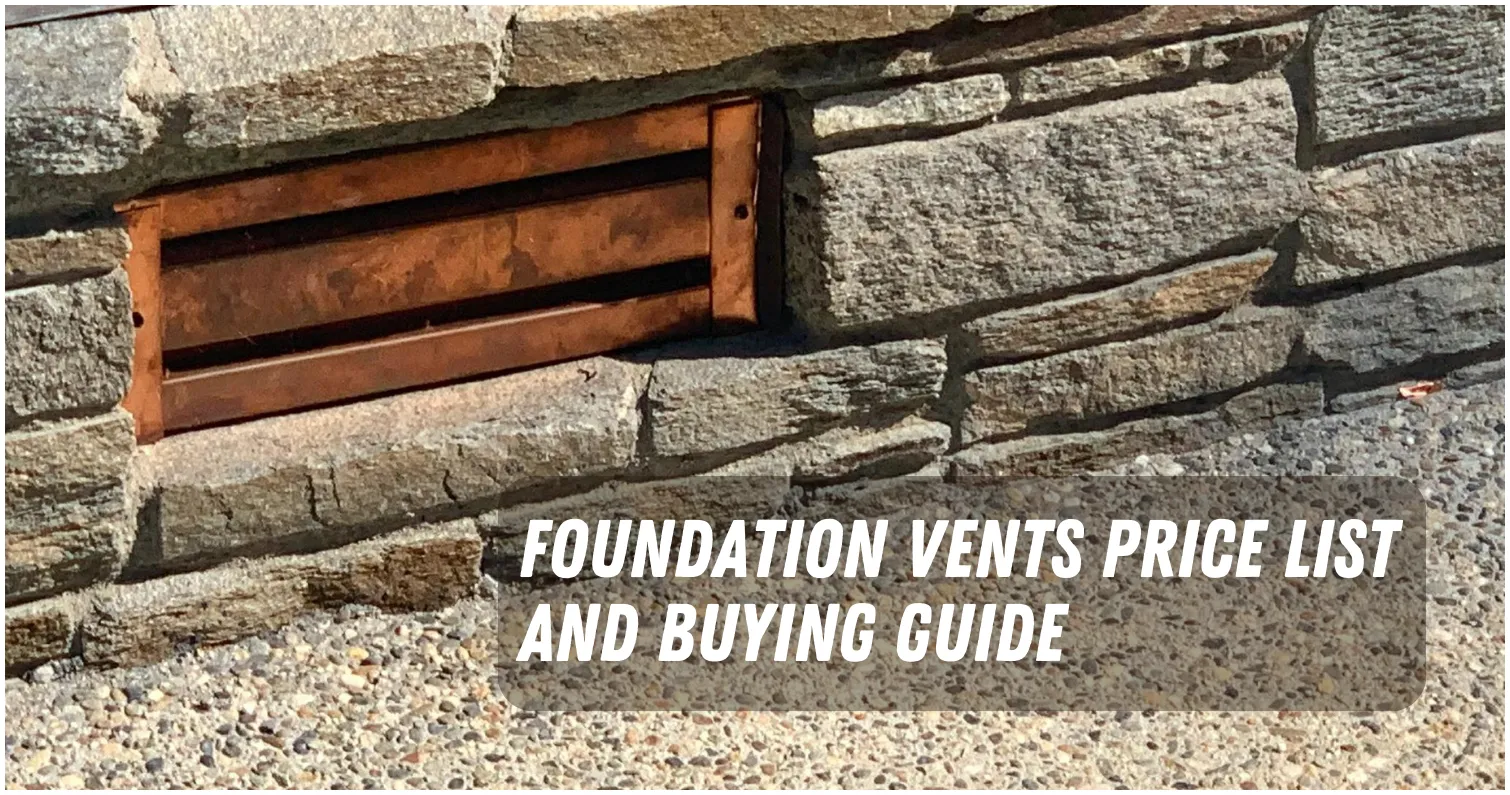If you are looking for a way to improve the ventilation and moisture control of your home’s foundation at low price, you might want to consider installing foundation vents.
Foundation vents are openings in the wall of the foundation that allow air to circulate and prevent moisture buildup.
They usually price between ₱1,000 to ₱2,500 depending on they type and brand you choose.
In this article, we will explain the price of foundation vents in Philippines and all you need to know about it.
What is Foundation Vents

Foundation vents are structured openings in a home’s foundation wall that promote airflow underneath the floor.
These vents are engineered to deter the accumulation of moisture, impede mold formation, and thwart pest infiltration within the crawl space.
Additionally, they aid in maintaining the house’s temperature by releasing heat during summer and letting in cold air during winter.
Foundation vents are usually made of metal, plastic, or wood, and come in different sizes and shapes.
They can be manual or automatic, depending on whether they have a mechanism that opens and closes them according to the outside temperature.
Manual vents need to be adjusted by hand, while automatic vents have a bi-metal coil that expands and contracts with the temperature changes.
Foundation Vents Purposes
The primary role of foundation vents is to ventilate the crawl space beneath the house, crucial for several reasons:
- Decreasing moisture levels, thus averting wood decay, rust, mold, mildew, and foul odors.
- Preventing termite and other pest invasions, thereby safeguarding the house’s structure and insulation.
- Enhancing indoor air quality by eliminating radon gas, carbon monoxide, and other pollutants.
- Reducing energy consumption by diminishing heating and cooling requirements.
Type of Foundation Vents

There are two main types of foundation vents: manual and automatic.
Manual
Manual vents are uncomplicated apertures that are maneuvered open or shut by shifting a cover or screen.
These vents are more cost-effective and straightforward to install than automatic vents, but they demand regular upkeep and adjustment.
Manual vents should be opened in summer for hot air to escape and closed in winter to restrict cold air from entering.
Automatic
Automatic vents offer a more high-tech and convenient solution. These vents house a bi-metal coil that responds to external temperature and accordingly adjusts the vent.
Automatic vents operate without manual interference or electricity, though they are costlier and more challenging to install.
For protection against rain, snow, or debris, automatic vents should be installed with a protective cover.
Foundation Vents Price List

The price of foundation vents depends on several factors, such as the type, size, material, brand, and installation cost.
The following table shows some examples of foundation vents prices in Philippines:
| Type | Size | Material | Brand | Price |
|---|---|---|---|---|
| Manual | 8 x 16 inches | Metal | BRN | ₱1,500 |
| Automatic | 8 x 16 inches | Metal | BRN | ₱2,500 |
| Manual | 8 x 16 inches | Plastic | ALMADECO | ₱1,000 |
| Automatic | 8 x 16 inches | Plastic | ALMADECO | ₱2,000 |
| Manual | 8 x 16 inches | Wood | Shoppable | ₱1,200 |
| Automatic | 8 x 16 inches | Wood | Shoppable | ₱2,200 |
Note: The prices are based on online sources and may vary depending on the availability, location, and quality of the products.
Foundation Vents Pros and Cons
Foundation vents have both advantages and disadvantages that should be considered before installing them. Here are some of them:
Pros:
- They prevent moisture problems that can damage the house and affect the health of the occupants.
- They deter pests that can cause structural and insulation issues.
- They improve indoor air quality by removing harmful gases and odors.
- They save energy by reducing the need for heating and cooling.
Cons:
- They can let in water, snow, or debris that can clog or damage the vents.
- They can allow cold air to enter in the winter, which can increase heating costs and cause pipes to freeze.
- They can reduce the effectiveness of insulation by creating gaps and air leaks.
- They can be noisy when they open or close.
Foundation Vents Alternative
An alternative to foundation vents is encapsulation.
Encapsulation is a process that involves sealing the crawl space with a vapor barrier and installing a dehumidifier or a fan to control the humidity level.
Encapsulation has several benefits over foundation vents, such as:
- It eliminates moisture problems that can cause mold, rot, rust, and odors.
- It prevents pest infestations that can damage the house and pose health risks.
- It improves indoor air quality by preventing radon gas, carbon monoxide, and other pollutants from entering.
- It increases energy efficiency by creating an air-tight space that reduces heat loss or gain.
However, encapsulation also has some drawbacks, such as:
- It is more expensive and complex than installing foundation vents.
- It requires regular maintenance and monitoring of the dehumidifier or fan.
- It may not be suitable for some climates or soil conditions.
Thing You Should Know about Foundation Vents
If you decide to install foundation vents, there are some things you should know to make the most of them. Here are some of them:
- How many vents for foundation?
The number of vents you need depends on the size and shape of your crawl space, but a general rule is to have one square foot of vent area for every 150 square feet of crawl space area. You should also have vents on at least two opposite sides of the house to create cross-ventilation. - Do I need foundation vents?
Foundation vents are not required by law, but they are recommended by most building codes and experts. Foundation vents can help prevent moisture, pest, and air quality problems that can affect the structure and comfort of your house. - Should foundation vents be open or closed?
During summer, foundation vents should be open to release hot air and closed during winter to restrict cold air from entering. However, this can vary based on climate and the vent type you have. - Do slab foundations have vents?
Slab foundations, which are poured directly on the ground, don’t require vents as they lack a crawl space. - When should you close foundation vents?
Foundation vents should be shut when outdoor temperatures drop below around 40 degrees Fahrenheit to prevent heat loss or pipe freezing. Nonetheless, keep an eye on the crawl space humidity level and open the vents if it elevates significantly.
We hope this article has helped you understand more about foundation vents price in Philippines and their benefits and drawbacks.
If you have any questions or comments, please feel free to contact us.
[ratings]

